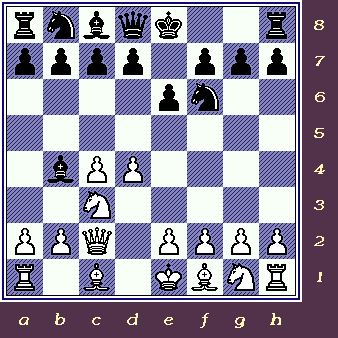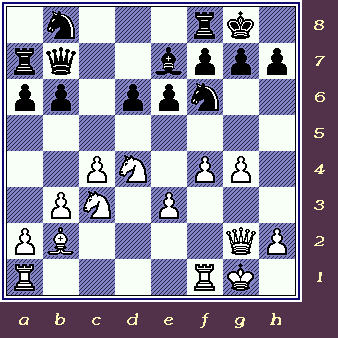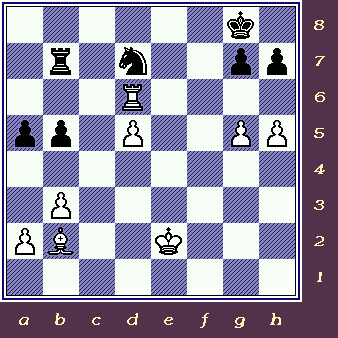GM
Loek Van Wely (2655) - GM Vladimir Akopian (2705)
|
|
|
My "GAME OF THE MONTH," ... for {the period of} August, 2005.
The Dutch team - in somewhat of a surprise, at least it was to me - won the ETC, (European Team Champ.); held in July and August of this year. In an exciting, near photo-finish, the Israeli team won their last-round match. This put the Dutch Team in a very unenviable position ... they HAD to win their last-round match; and in order to win the title, the Dutchmen had to defeat a very strong Polish team. (Which was in medal contention.) They did so in brilliant fashion ... and thus won the title. (The big surprise was the failure of any Soviet/Russian team, the main men's team was not even in medal contention in the final rounds!)
(You can read all about it on the ChessBase website, see the following link ... ... ...
- http://www.chessbase.com/newsdetail.asp?newsid=2563.)
Here is an exciting, key fourth-round victory, that allowed this team (representing the Netherlands) to slip past the powerful Armenian (men's) Team. (The other three games of this match were all drawn.)
*******************************************
{The ratings are correct according to international standards, and have been checked against the official FIDE website.}
1.d4 Nf6;
2.c4 e6; 3.Nc3 Bb4;
The Nimzo-Indian, a strong and reliable opening system.
It was pioneered by the great hypermodern player, Aaron Nimzowitsch, who was also a legitimate title contender ...
in his very best years.
At one time, to play this system would have raised eyebrows at the master-level, but the Soviet players refined this
line for nearly 75 years, and at the highest levels. (Many western players, like Bobby Fischer, also made valuable
contributions to the theory of this opening.) Today, when a master plays this opening, most people do not even give
it a second thought ... which shows how much chess has changed over the last one hundred years.
I personally have at least a dozen books that are dedicated to just this one opening system, and this does not count
general reference works like ECO, MCO, NCO, etc. Today, there are dozens of lines, sub-systems and variations ...
and one has to be an expert in the theory of a specific line, in order not to be "thrown off your horse" by a surprise
anywhere in this complicated and diverse opening system.
4.Qc2 , {See
the diagram given, just below.}
The Classical System, White gets out a piece, and most importantly, prevents the doubling of the pawns that can
occur in most other systems.
The main alternative here is to play: 4.e3, which is "The Rubinstein System."
(Of course, there are many other lines that White can play as well.)
********************************************
|
|
********************************************
rnbqk2r/pppp1ppp/4pn2/8/1bPP4/2N5/PPQ1PPPP/R1B1KBNR (B)
Qc2 was played by many different players, but the FIRST player to show this system had real teeth,
{at least - in my own opinion}; was none other than Jose Raul Capablanca,
chess's very first GM.
(Editor's note: If you click on Capa's name, you
will automatically be given a search result from Google.
The fourth or fifth article down, from
"Absolute-astronomy" makes for interesting reading.)
[ Another possibility would be:
4.e3 0-0; 5.Bd3 d5;
6.Nf3 c5; 7.0-0 Nc6;
"~"
with a rich position ... White may have at least a slight edge, due simply to the advantage
of having moved first.
One of the more notable (GM) examples would have to be:
Boris Spassky - Robert J.
Fischer; World Championship Match /
Game #1
Reykjavik, Iceland; 1972.
(1-0, 56 moves.) /
{White won a long and tough struggle.}
A very recent GM example would be:
A. Graf (2605) -
A. Moiseenko (2664); /
The 15th E.T.C. {A team event.}
Gothenburg, SWE; 8,2005.
(1/2 - 1/2)
{This was a very long, and a very difficult game, I went over it in some detail,
although I did not subject it to any real analysis. It was eventually drawn, after
68 hard-fought moves. It also showed the value of knowing the
basic positions
of any R+P ending!
---> The final position was one that Philidor himself proved to be a draw.} ]
4...c5;
Black can also castle here, although the two moves are virtually interchangeable for Black at this point.
[ One of the most popular of all the general, opening works gives the line:
(>/=) 4...0-0; 5.a3 Bxc3+;
6.Qxc3 b6!?;
Currently this is one of Black's most popular and viable tries at this point.
( A playable alternative is: ("=") 6...Ne4!?;
7.Qc2 f5; "~"
when Black has a reasonable position. )
7.Bg5 Bb7; 8.f3 h6;
9.Bh4 d5; 10.e3 Nbd7; 11.cxd5 Nxd5!;
12.Bxd8 Nxc3; 13.Bh4,
"+/=" 13...Nd5; (The end of the column.)
14.Bf2 f5; 15.Bb5!? c6; 16.Bd3
e5; 17.Ne2 Rae8; "<=>"
{Diag?}
Black appears to have nearly equalized - and has good play - yet MCO
{claims} ... "just a minute edge for White."
('+/=') -
GM Nick de Firmian
Piket - Karpov;
Match Game/1999. {This game was drawn in 41 moves.}
[ See MCO-14, column # 01;
page 532, and also note # (g.). ] ]
5.dxc5 Qc7;
The Queen often comes into play on this square, although I have to wonder - at least a little bit -
if this might not be a tad premature.
[ The most solid move is:
5...0-0;
see any good book on the openings.
{Any general reference work will
do.} ]
6.Nf3 Bxc5;
7.g3, ('!?')
Hmmm, this is interesting, but Fritz likes the simple a3 here ... and so do I!
7...Qb6!?;
This hits the sensitive f2-square, but it is also an obvious loss of tempo as
well.
(This is not a new move, Akopian had used it before against Khalifman at the FIDE World Championship
{knock-out} tournament in Las Vegas, in the year 1999. The
CB website says
that there are 16 games in
the DB with this position.) [Editor's note:
You can simply right-click on any position with the program
CB 9.0, and the computer will automatically
search the games database that you select.]
[ Maybe better was:
(>/=)
7...a6; 8.Bg2 Be7!;
9.b3 b6; 10.0-0 Bb7;
11.Bf4 d6; 12.Rfd1 0-0;
"~" {Diagram?}
(equal?) with a fairly good game for Black here.
I could only find one game in the {games} database, with this position:
NM Saurabh Kherdekar
(2299) - GM Andrei Shariyazdanov
(2532);
ICT / Chhattisgarh Trophy /
Raipur, IND; (Round #4) / 2002.
{An obvious ratings mismatch, it also showed in the game, with Black
getting a nice win in under 50 moves.}
]
Both sides continue their development in a relatively normal manner.
8.e3 Be7!;
Practice has shown that Black gets into trouble if he leaves this piece outside the Pawn chain.
9.Bg2 a6;
10.b3!? (TN),
(fianchetto)
Apparently ... this move is new to normal opening theory ... and (also)
takes us out of book.
Of course there is nothing wrong
with this move, in fact ... it is very logical.
(White sees that e3 blocked in the QB, and attempts to immediately improve the scope of this piece.)
[ Standard theory gives:
10.0-0 Qc7; 11.b3 d6; 12.Bb2 Nbd7;
13.Ng5!?, "+/=" {Diagram?}
When White had a solid {small}
plus, and a slight initiative.
(Although Black eventually won this particular contest.)
GM Boris Alterman - GM Leonid Yudasin;
/
National Championship Tournament
/ Ramat Aviv, ISR; 2000.
(Black
won a tough game, 0-1 in 40 moves.) ]
10...Qc7;
11.Nd4 0-0; 12.0-0 d6;
13.Bb2 Ra7!?;
This appears a bit extravagant ... but not to an extreme degree.
[ (>/=) 13...Bd7; 14.Rad1 Rc8; ("~" or "=" ?) etc. ]
14.Qe2 b6;
15.f4! Bb7;
16.g4!?, (space)
White initiates a rapier wing attack ... but one which seems to have {primarily} a
positional goal.
[ 16.f5!?, "+/=" ]
16...Bxg2;
17.Qxg2 Qb7!?; ('?!') {See
the diagram given, just below.}
Maybe its too early for an exchange of Queens in this position. (17...Nfd7; with the idea of 18...Rc8;
and then 19...Nc6; might have been a little more solid.) (I
think this might be an improvement over
the actual game, ... but I am not 100% sure. It's definitely worth
analyzing on your own. - Editor.)
********************************************
|
|
********************************************
1n3rk1/rq2bppp/pp1ppn2/8/2PN1PP1/1PN1P3/PB4QP/R4RK1
(W)
I am sure that, without really meaning to, Black has drifted into a colorless position that gives White a solid edge.
("A cramped position bears the germs of defeat," says one of the greatest chess teachers of all time.)
18.g5 Qxg2+;
19.Kxg2 Nfd7; 20.h4! Re8!?; (Probably dubious, '?!')
This move has little real value, and seems to be completely aimless.
[ The move of >/= 20...Nc5; was practically forced ("[]") for Black. ]
21.Rfd1 Rc7;
22.Rd2 Nc6; 23.Nde2!, (Why?)
The great Tarrasch also taught that when you have an opponent in a badly cramped position -
that you should avoid unnecessary exchanges.
[ Or 23.Nxc6 Rxc6; 24.Rad1, "+/=" with a solid edge for White. ]
23...f5;
{Box?}
Black probably felt that this was pretty much forced, White had the plan to simply play Rad1
and then Ne4; annexing the d-pawn.
24.e4! Rf8;
25.exf5 Rxf5; "[]"
Sadly - this also might be forced for Akopian here.
[
Even worse would be:
</= 25...exf5?!; ('?')
26.Nd5 Rb7;
27.Nd4!
'±' ("+/-")
which is practically winning for White.
]
26.Ne4 e5!?;
Black is getting desperate.
[ The continuation of:
26...d5;
27.N4g3 Rf8; 28.cxd5 exd5; 29.Rxd5, '±'
is also no fun for Black, who is a whole Pawn down ...
with no real compensation at all in this position.
]
27.Nxd6 Bxd6;
28.Rxd6 exf4;
29.Rf1 Ne7!?; (hmmm)
As soon as White captures the button on f4, Black will be a whole point down
with
really nothing to show for his troubles.
[
(>/=)
29...f3+; 30.Rxf3 Rxf3;
31.Kxf3, '±' 31...Nc5;
etc.
(Editor's
note: This MIGHT be a tiny improvement over the game ...
at
least Black is not in such a bind as he gets into ... in the manner
that
the game is actually played out by GM Vladimir Akopian.) ]
The rest of the game requires little comment, Black's position is quickly reduced to rubble.
30.Nxf4 Rb7;
31.Nd5 Nxd5!?;
32.cxd5 Rxf1; 33.Kxf1 a5;
34.h5! b5!?; 35.Ke2, ('!')
(The
endgame phase.) {Diagram ... just
below.}
The King is a fighting piece ... and should always be so used ... late in any contest, such as White does here.
********************************************
|
|
********************************************
6k1/1r1n2pp/3R4/pp1P2PP/8/1P6/PB2K3/8
(Black to move.)
There is no real danger for the White Monarch, Black is virtually contained to his first two ranks.
[ Another try was: 35.Bc3!? ]
Now all that is left for the talented GM Van Wely, is to attach a few decorative ribbons to his already neat package.
(Black could quit anytime here, but plays on until it obvious that he is losing even more material.)
35...Kf8;
36.Bd4! b4;
37.Kd3 Ke7; 38.Ra6 Kf7;
39.Kc4 Rc7+; 40.Rc6 Rb7;
41.g6+! hxg6;
42.hxg6+ Ke8;
43.d6 Kd8; 44.Ra6, ("+/-") Black has had enough.
(So he resigns.)
An excellent game by Loek Van Wely, who at one time, was a virtual chess prodigy.
(Now in his early thirties, he has matured into an extremely solid and powerful GM.)
My congrats also to Van Wely's team on winning the event ... and the
Gold Medal as well!
Copyright (c) A.J. Goldsby, 2005. All rights reserved.


